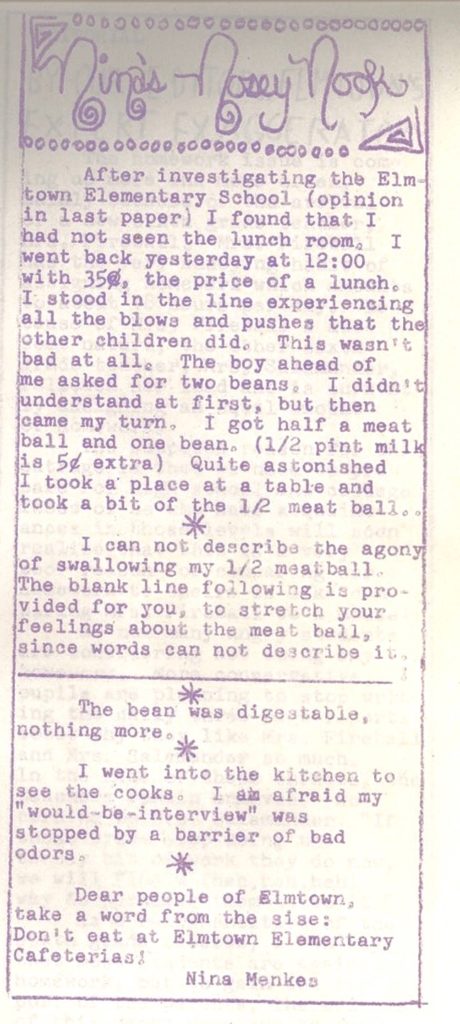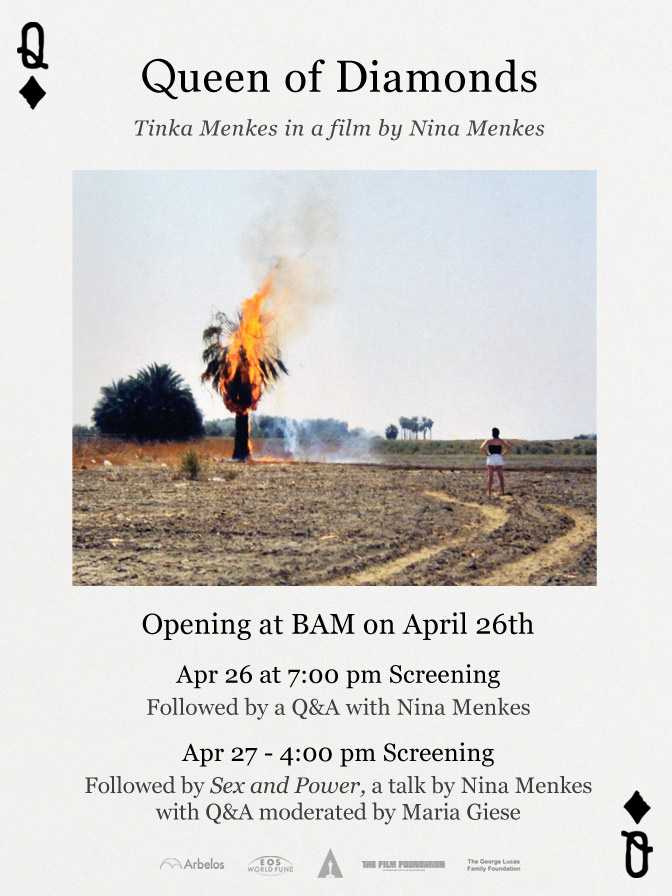BAM presents a new restoration of Nina Menkes’ unsung masterpiece Queen of Diamonds (1991), Apr 26—May 2
March 26, 2019/Brooklyn, NY—From Friday, April 26 through Thursday, May 2, BAM presents a brand new 4k restoration of Nina Menkes’ radical, feminist feature, Queen of Diamonds (1991). Menkes will appear in person following the 7pm screening on April 26; she will also present her celebrated talk Sex and Power: The Visual Language of Oppression, followed by a Q&A, on April 27.
For ticket information, call BAM Ticket Services at 718.636.4100, or visit BAM.org
In one of the most jarringly original independent films of the 1990s, a disaffected blackjack dealer, (played by the director’s sister Tinka Menkes), drifts through a neon-soaked dream vision of Las Vegas and experiences a series of encounters alternately mundane, surreal, and menacing, while death and violence hover ever-present in the margins. Awash in lush, hallucinatory images, Queen of Diamonds is a haunting study of female alienation with intellectual heft and formal rigor, from a filmmaker whose work can be compared to Akerman, Fassbinder, and Lynch, but with a unique, singular vision all her own.
Queen of Diamonds will also be presented, along with Menkes’s nightmarish true-crime feature The Bloody Child, by the UCLA Film and Television Archive at the Billy Wilder Theater in Los Angeles on June 15th.
Based on her viral Filmmaker Magazine article “The Visual Language of Oppression: Harvey Weinstein Wasn’t Working in a Vacuum,” Menkes’ Sex and Power examines the ways formal shot design is gendered. Analyzing a series of film clips by major filmmakers—including Scorsese, WIm Wenders, Welles, Spike Lee, and many others—Menkes shows how traditional cinematic language underlies and supports sexual assault, harassment, and employment discrimination against women. The presentation has appeared at Sundance, Cannes, and the AFI International Film Festival, and is currently being made into a feature length documentary. Maria Giese, who instigated the historic ACLU and EEOC investigations against the Hollywood studios’ Title VII violations, will moderate a discussion following the talk.
Nina Menkes is the writer, director, and cinematographer of six feature films, including Magdalena Viraga (1986), Phantom Love (2007) and Dissolution (2012). Her films have shown widely at major festivals, including Sundance, Locarno, the Berlinale and she has had retrospectives internationally. Menkes has received American Film Institute and Guggenheim Fellowships, and was an artist-in-residence under the DAAD Artists-in-Berlin Program. She is currently a faculty member at California Institute of the Arts, and developing two new projects: Minotaur Rex, a horror-drama about the Israeli-Palestinian conflict, (produced by Eos World Fund), and Heatstroke a psychological thriller about two sisters set in Cairo and LA (produced by Marginalia Pictures).
Queen of Diamonds
Approx. 77 min. | DCP
An Arbelos Release
Co-Presented by EOS World Fund
Director, Writer, Cinematographer: Nina Menkes
Starring Tinka Menkes
“[Queen of Diamonds] may become for America in the 90s what Jeanne Dielman was for Europe in the 70s—a cult classic using rigorous visual composition to penetrate the innermost recesses of the soul.”–Bérénice Reynaud, Chicago Reader
“Shimmering, hypnotic… Tacky, barren side-street Vegas is a perfect locale for the director’s vision of alienation and decay as she evokes a sense of the cycle of life and death.”
–Kevin Thomas, The Los Angeles Times
“[Menkes’ films] seem to emanate directly from her psyche. All are efforts to give form to something intangible, to film an inner state. It’s a tricky task that Ms. Menkes accomplishes through long takes and wide-angle compositions, layered sound designs and oblique editing schemes, all of which make time and space seem like subjective dimensions, vulnerable to the warping effects of mood and memory… No less than David Lynch, Ms. Menkes is an artist of the unconscious for whom the creative and the spiritual quest are one and the same.”
–Dennis Lim, The New York Times
New restoration by The Academy Film Archive and The Film Foundation, with funding provided by The George Lucas Foundation. The film will be co-presented with Eos World Fund.
About BAM Film
Since 1998 BAM Rose Cinemas has been Brooklyn’s home for alternative, documentary, art-house, and independent films. Combining new releases with year-round repertory program, the four-screen venue hosts new and rarely seen contemporary films, classics, work by local artists, and festivals of films from around the world, often with special appearances by directors, actors, and other guests. BAM has hosted major retrospectives of filmmakers like Spike Lee, Chantal Akerman, John Carpenter, Manoel de Oliveira, Luis Buñuel, King Hu, and Vincente Minnelli (winning a National Film Critics’ Circle Award prize for the retrospective), and hosted the first US retrospectives of directors Arnaud Desplechin, Hong Sang-soo, Andrzej Zulawski, and Jiang Wen. Since 2009 the program has also produced BAMcinemaFest, New York’s home for American independent film, and has championed the work of filmmakers like Janicza Bravo, Andrew Dosunmu, Lena Dunham, and Alex Ross Perry. The 12-day festival of New York premieres, now in its eleventh year, runs from June 12—23, 2019.
Credits:
Leadership support for BAM Film programs provided by The Thompson Family Foundation
Support for A Year of Resistance, amplifying marginalized voices in cinema, provided by The Academy of Motion Picture Arts and Sciences
BAM Rose Cinemas would also like to acknowledge the generous support of The Peter Jay Sharp Foundation, Brooklyn Borough President Eric L. Adams, Brooklyn Delegation of the New York City Council, New York City Department of Cultural Affairs, New York State Council on the Arts, and Bloomberg
Delta Air Lines is the Official Airline of BAM
The Brooklyn Hospital Center is the Official Healthcare Provider of BAM
Your tax dollars make BAM programs possible through funding from the City of New York Department of Cultural Affairs and the New York State Council on the Arts with the support of Governor Andrew M. Cuomo and the New York State Legislature. The BAM facilities are owned by the City of New York and benefit from public funds provided through the New York City Department of Cultural Affairs with support from Mayor Bill de Blasio; Cultural Affairs Commissioner Tom Finkelpearl; the New York City Council including Council Speaker Corey Johnson, Finance Committee Chair Julissa Ferreras, Cultural Affairs Committee Chair Jimmy Van Bramer, Councilmember Laurie Cumbo, and the Brooklyn Delegation of the Council; and Brooklyn Borough President Eric L. Adams. BAM would like to thank the Brooklyn Delegations of the New York State Assembly, Joseph R. Lentol, Delegation Leader; and New York Senate, Senator Velmanette Montgomery.
Special thanks to: Ei Toshinari, David Marriott, and Dennis Bartok/Arbelos Films;
California Institute of the Arts.
General Information
BAM Howard Gilman Opera House, BAM Rose Cinemas, and BAMcafé are located in the Peter Jay Sharp building at 30 Lafayette Avenue (between St Felix Street and Ashland Place) in the Fort Greene neighborhood of Brooklyn. BAM Harvey Theater is located two blocks from the main building at 651 Fulton Street (between Ashland and Rockwell Places). Both locations house Greenlight Bookstore at BAM kiosks. BAM Fisher, located at 321 Ashland Place (between Lafayette Ave and Hanson Place), houses the Judith and Alan Fishman Space and Rita K. Hillman Studio. BAM Rose Cinemas features first-run independent and foreign film and repertory programming.
Subway: 2, 3, 4, 5, Q, B to Atlantic Avenue – Barclays Center (2, 3, 4, 5 to Nevins St for Harvey Theater) D, N, R to Pacific Street; G to Fulton Street; C to Lafayette Avenue
Train: Long Island Railroad to Atlantic Terminal – Barclays Center
Bus: B25, B26, B41, B45, B52, B63, B67 all stop within three blocks of BAM
For ticket information, call BAM Ticket Services at 718.636.4100, or visit BAM.org





